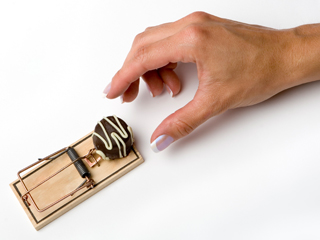Escape the Sugar Trap

By: IZABELA PLUCINSKA, CRNP
At lunch, you enjoy a nice cold soda – containing 12 teaspoons of sugar. On the way home, you stop at your favorite coffee shop for a refreshing Double Vanilla Caramel Mocha Latte – and 18 teaspoons of sugar.
It’s no secret that we eat too much sugar. The American Heart Association recommends that women consume no more than six teaspoons of added sugar per day and that men should not exceed nine teaspoons. The reality is a typical American – adult and child – consumes 17 teaspoons of added sugar per day. We are caught in a sugar trap.
Sugar is everywhere
Sugar occurs naturally in many whole foods, and our bodies need it to burn for energy. However, food manufacturers also add sugar to many products to increase flavor or extend shelf life. Sugary drinks, candy, baked goods and sweetened dairy are the main sources of added sugar. But even foods like soups, bread, cured meats, tomato sauce and ketchup can have extra sugar, making it easy for us to overdose on the sweet stuff.
While natural foods have sugar, they also contain the nutrients our bodies need to be healthy. Not so with sugary processed foods: they are mostly “empty calories” that give you little nutritional benefit.
Excess sugar consumption can have a serious impact on your health. It is a major factor in obesity, which affects 36% of all adults and 19% of all children. Among other things, obesity can lead to high blood pressure, coronary heart disease, high cholesterol, stroke and type 2 diabetes.
Getting free from sugar
Since added sugar is so common, you need to be carefully choosing your foods. Here are some tips to get you started:
- Dump the sweet drinks: Many Americans get about 22% of their total calories from sweetened drinks, including soda, fruit juices, sports and energy drinks, and sweetened coffees. Instead, go with 100% fruit juice, sugar-free flavored water, or diet sodas, if you must have soda. Try to get your calories from foods, not drinks. And try to decrease your need for sweet-tasting foods and drinks generally.
- Toss the table sugar: Whether it’s white, brown, corn syrup, honey, agave or molasses, it’s all sugar. Cut back on the amount of sweetener you add to foods like cereal, coffee or tea. Try cutting the usual amount you add by half and then keep decreasing it.
- Favor fresh, frozen, dried or canned fruits: Choose fruit canned in water or natural juice. Avoid fruit canned in syrup, especially heavy syrup. Instead of adding sugar to cereal or oatmeal, try fresh or dried fruit.
- Cut back when cooking: When baking cookies, brownies or cakes, cut the sugar in your recipe by one-third to one-half. (You may not notice the difference.) Or reduce sugar by substituting half the amount with unsweetened applesauce or mashed banana. You can also use flavor extracts like almond, vanilla, orange or lemon instead of sugar.
- Look at the label: Read the ingredients and Nutrition Facts labels on packaged foods to find ones with less sugar:
- Beware of products that list sugar as their first or second ingredient. However, to hide how much sugar they use, food makers may use variety of sweeteners and list each one individually, so read the whole label.
- Look for the Daily Value (DV) for sugar on the Nutrition Facts label. This is a percentage of the recommended limit for sugar in your daily diet. The label lists both “Total Sugars” and underneath “Added Sugars.” 5% DV or less of added sugar per serving is considered low, while 20% DV or more of added sugar per serving is considered high
Your MPCP provider can also help you plan a healthy diet and suggest other ways to escape the sugar trap.
 Izabela Plucinska, Certified Registered Nurse Practitioner, received her Master of Science in Nursing degree from the MGH Institute of Health Professions, with a specialty in Women’s Health. She is board certified by the American Nurses Credentialing Center in Family Practice, and treats patients in the Arnold office.
Izabela Plucinska, Certified Registered Nurse Practitioner, received her Master of Science in Nursing degree from the MGH Institute of Health Professions, with a specialty in Women’s Health. She is board certified by the American Nurses Credentialing Center in Family Practice, and treats patients in the Arnold office.
Recommended Posts
Spring-clean Your Way to Better Health
By Arlene Cabrera, FNP-C
Careful with the Caffeine
By Paul Chite, M.D.
YIKES! I’m Too Young to Have High Blood Pressure and Diabetes
By Daniel Lamphier, M.D.



